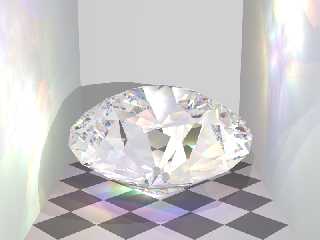|
 |
From my Material IORs chart:
Glass, Fused Silica 1.459
Glass, Albite 1.489
Glass, Crown, Zinc 1.517
Glass 1.51714
Glass, Crown 1.52
Quartz 1.544
Glass, Flint (29% Lead) 1.569
Glass, Flint (light) 1.58038
Glass, Flint (medium) 1.62725
Glass, Flint (heavy) 1.65548
Glass, Flint (dense) 1.66
Glass, Flint (55% Lead) 1.669
Glass, Flint (Lanthanum) 1.8
Glass, Flint (71% Lead) 1.805
Glass, Flint (heaviest) 1.89
Glass, Arsenic Trisulfide 2.04
Diamond 2.417
--
Tim Cook
http://home.bellsouth.net/p/PWP-empyrean
-----BEGIN GEEK CODE BLOCK-----
Version: 3.12
GFA dpu- s: a?-- C++(++++) U P? L E--- W++(+++)>$
N++ o? K- w(+) O? M-(--) V? PS+(+++) PE(--) Y(--)
PGP-(--) t* 5++>+++++ X+ R* tv+ b++(+++) DI
D++(---) G(++) e*>++ h+ !r--- !y--
------END GEEK CODE BLOCK------
Post a reply to this message
|
 |
|
 |
Tim Cook <z99### [at] bellsouth net> wrote:
> From my Material IORs chart:
> Diamond 2.417
Correct, so why does consts.inc still have
#declare Diamond_Ior = 2.47;
like it has since the days of DKBTrace? :(
Attached is an Ideal-Cut diamond with correct IOR, but the photons are not
quite realistic, although it does give a rather pretty effect, IMNSHO. :)
// Persistence of Vision Ray Tracer version 3.5 Include File
// File: brilliant5.inc
// Desc: The 'brilliant' gem-cut. Parameters from "Diamond Design" by
M.Tolkowsky
// Date: 2004.5.28
// Auth: PM 2Ring
// The "Brilliant" object is centered on the Origin, with girdle in the XZ
plane.
//
// INCLUDE FILE: DO NOT RENDER DIRECTLY!
#version 3.5;
//"Brilliant" parameters from "Diamond Design" by Tolkowsky. h:height,
r:radius, a:angle
#local htable = 0.324;
#local rtable = 0.550 * .89;
#local rgird = 1.000;
#local hpav = -0.862;
#local hculet = hpav+1/64;
#local acrown = -34.5;
#local astar = -20;
#local agirdhi = -39;
#local agirdlo = 42.75;
#local apav = 40.75;
#local ff=.9815; //Fudge factor. Well, you know... :)
//Create MK facets, 'phase' K. Facet 0 passes through (X,Y,0) at angle A.
//N is facet (normal) direction: 1=face up, -1=face down.
#macro Facet(K, MK, X, Y, A, N)
#local T=radians(A);
//Find height of plane through (X,Y,0), with angle A to +ve X-axis
#local H=N*(Y*cos(T) - X*sin(T));
#while (K<MK)
plane{N*y,H rotate <A,360*K/MK,0>}
#local K=K+1;
#end
#end
//Brilliant cut
#local BBound = cylinder{hculet*y, htable*y, rgird}
//#local BBound = box{<-rgird,hculet,-rgird>, <rgird,htable,rgird>}
#declare Brilliant =
intersection{
object{BBound}
plane{y,htable} //Table
Facet(0.5, 8, rtable,htable,astar, 1) //Stars
Facet(0.0, 8, rgird,0,acrown, 1) //Crown
Facet(0.5,16, rgird*ff,0,agirdhi, 1) //Upper Girdle
Facet(0.5,16, rgird*ff,0,agirdlo, -1) //Lower Girdle
Facet(0.0 ,8, 0,hpav,apav, -1) //Pavillion
plane{-y,-hculet} //Culet
bounded_by{BBound scale 1.001}
}
//Conical Brilliant
#declare BrillCone =
merge{
cone{0,rgird, y*htable,rtable}
cone{y*hpav,0, 0,rgird}
}
// ---------------------------------------- net> wrote:
> From my Material IORs chart:
> Diamond 2.417
Correct, so why does consts.inc still have
#declare Diamond_Ior = 2.47;
like it has since the days of DKBTrace? :(
Attached is an Ideal-Cut diamond with correct IOR, but the photons are not
quite realistic, although it does give a rather pretty effect, IMNSHO. :)
// Persistence of Vision Ray Tracer version 3.5 Include File
// File: brilliant5.inc
// Desc: The 'brilliant' gem-cut. Parameters from "Diamond Design" by
M.Tolkowsky
// Date: 2004.5.28
// Auth: PM 2Ring
// The "Brilliant" object is centered on the Origin, with girdle in the XZ
plane.
//
// INCLUDE FILE: DO NOT RENDER DIRECTLY!
#version 3.5;
//"Brilliant" parameters from "Diamond Design" by Tolkowsky. h:height,
r:radius, a:angle
#local htable = 0.324;
#local rtable = 0.550 * .89;
#local rgird = 1.000;
#local hpav = -0.862;
#local hculet = hpav+1/64;
#local acrown = -34.5;
#local astar = -20;
#local agirdhi = -39;
#local agirdlo = 42.75;
#local apav = 40.75;
#local ff=.9815; //Fudge factor. Well, you know... :)
//Create MK facets, 'phase' K. Facet 0 passes through (X,Y,0) at angle A.
//N is facet (normal) direction: 1=face up, -1=face down.
#macro Facet(K, MK, X, Y, A, N)
#local T=radians(A);
//Find height of plane through (X,Y,0), with angle A to +ve X-axis
#local H=N*(Y*cos(T) - X*sin(T));
#while (K<MK)
plane{N*y,H rotate <A,360*K/MK,0>}
#local K=K+1;
#end
#end
//Brilliant cut
#local BBound = cylinder{hculet*y, htable*y, rgird}
//#local BBound = box{<-rgird,hculet,-rgird>, <rgird,htable,rgird>}
#declare Brilliant =
intersection{
object{BBound}
plane{y,htable} //Table
Facet(0.5, 8, rtable,htable,astar, 1) //Stars
Facet(0.0, 8, rgird,0,acrown, 1) //Crown
Facet(0.5,16, rgird*ff,0,agirdhi, 1) //Upper Girdle
Facet(0.5,16, rgird*ff,0,agirdlo, -1) //Lower Girdle
Facet(0.0 ,8, 0,hpav,apav, -1) //Pavillion
plane{-y,-hculet} //Culet
bounded_by{BBound scale 1.001}
}
//Conical Brilliant
#declare BrillCone =
merge{
cone{0,rgird, y*htable,rtable}
cone{y*hpav,0, 0,rgird}
}
// ----------------------------------------
Post a reply to this message
Attachments:
Download 'diamondq2.png' (304 KB)
Preview of image 'diamondq2.png'

|
 |




![]()